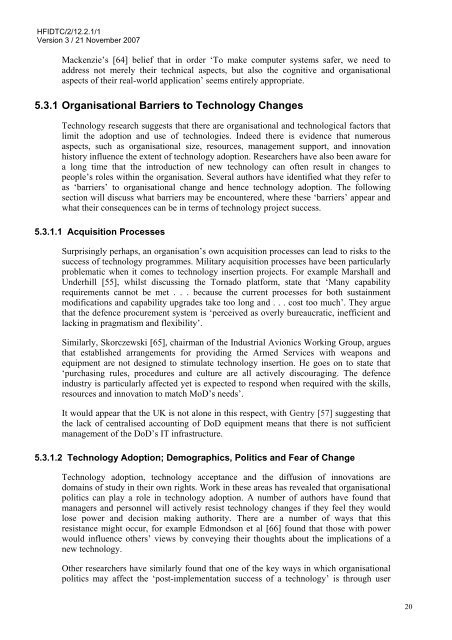The Impact of Technology Insertion on Organisations
The Impact of Technology Insertion on Organisations
The Impact of Technology Insertion on Organisations
You also want an ePaper? Increase the reach of your titles
YUMPU automatically turns print PDFs into web optimized ePapers that Google loves.
HFIDTC/2/12.2.1/1<br />
Versi<strong>on</strong> 3 / 21 November 2007<br />
Mackenzie’s [64] belief that in order ‘To make computer systems safer, we need to<br />
address not merely their technical aspects, but also the cognitive and organisati<strong>on</strong>al<br />
aspects <str<strong>on</strong>g>of</str<strong>on</strong>g> their real-world applicati<strong>on</strong>’ seems entirely appropriate.<br />
5.3.1 Organisati<strong>on</strong>al Barriers to <str<strong>on</strong>g>Technology</str<strong>on</strong>g> Changes<br />
<str<strong>on</strong>g>Technology</str<strong>on</strong>g> research suggests that there are organisati<strong>on</strong>al and technological factors that<br />
limit the adopti<strong>on</strong> and use <str<strong>on</strong>g>of</str<strong>on</strong>g> technologies. Indeed there is evidence that numerous<br />
aspects, such as organisati<strong>on</strong>al size, resources, management support, and innovati<strong>on</strong><br />
history influence the extent <str<strong>on</strong>g>of</str<strong>on</strong>g> technology adopti<strong>on</strong>. Researchers have also been aware for<br />
a l<strong>on</strong>g time that the introducti<strong>on</strong> <str<strong>on</strong>g>of</str<strong>on</strong>g> new technology can <str<strong>on</strong>g>of</str<strong>on</strong>g>ten result in changes to<br />
people’s roles within the organisati<strong>on</strong>. Several authors have identified what they refer to<br />
as ‘barriers’ to organisati<strong>on</strong>al change and hence technology adopti<strong>on</strong>. <str<strong>on</strong>g>The</str<strong>on</strong>g> following<br />
secti<strong>on</strong> will discuss what barriers may be encountered, where these ‘barriers’ appear and<br />
what their c<strong>on</strong>sequences can be in terms <str<strong>on</strong>g>of</str<strong>on</strong>g> technology project success.<br />
5.3.1.1 Acquisiti<strong>on</strong> Processes<br />
Surprisingly perhaps, an organisati<strong>on</strong>’s own acquisiti<strong>on</strong> processes can lead to risks to the<br />
success <str<strong>on</strong>g>of</str<strong>on</strong>g> technology programmes. Military acquisiti<strong>on</strong> processes have been particularly<br />
problematic when it comes to technology inserti<strong>on</strong> projects. For example Marshall and<br />
Underhill [55], whilst discussing the Tornado platform, state that ‘Many capability<br />
requirements cannot be met . . . because the current processes for both sustainment<br />
modificati<strong>on</strong>s and capability upgrades take too l<strong>on</strong>g and . . . cost too much’. <str<strong>on</strong>g>The</str<strong>on</strong>g>y argue<br />
that the defence procurement system is ‘perceived as overly bureaucratic, inefficient and<br />
lacking in pragmatism and flexibility’.<br />
Similarly, Skorczewski [65], chairman <str<strong>on</strong>g>of</str<strong>on</strong>g> the Industrial Avi<strong>on</strong>ics Working Group, argues<br />
that established arrangements for providing the Armed Services with weap<strong>on</strong>s and<br />
equipment are not designed to stimulate technology inserti<strong>on</strong>. He goes <strong>on</strong> to state that<br />
‘purchasing rules, procedures and culture are all actively discouraging. <str<strong>on</strong>g>The</str<strong>on</strong>g> defence<br />
industry is particularly affected yet is expected to resp<strong>on</strong>d when required with the skills,<br />
resources and innovati<strong>on</strong> to match MoD’s needs’.<br />
It would appear that the UK is not al<strong>on</strong>e in this respect, with Gentry [57] suggesting that<br />
the lack <str<strong>on</strong>g>of</str<strong>on</strong>g> centralised accounting <str<strong>on</strong>g>of</str<strong>on</strong>g> DoD equipment means that there is not sufficient<br />
management <str<strong>on</strong>g>of</str<strong>on</strong>g> the DoD’s IT infrastructure.<br />
5.3.1.2 <str<strong>on</strong>g>Technology</str<strong>on</strong>g> Adopti<strong>on</strong>; Demographics, Politics and Fear <str<strong>on</strong>g>of</str<strong>on</strong>g> Change<br />
<str<strong>on</strong>g>Technology</str<strong>on</strong>g> adopti<strong>on</strong>, technology acceptance and the diffusi<strong>on</strong> <str<strong>on</strong>g>of</str<strong>on</strong>g> innovati<strong>on</strong>s are<br />
domains <str<strong>on</strong>g>of</str<strong>on</strong>g> study in their own rights. Work in these areas has revealed that organisati<strong>on</strong>al<br />
politics can play a role in technology adopti<strong>on</strong>. A number <str<strong>on</strong>g>of</str<strong>on</strong>g> authors have found that<br />
managers and pers<strong>on</strong>nel will actively resist technology changes if they feel they would<br />
lose power and decisi<strong>on</strong> making authority. <str<strong>on</strong>g>The</str<strong>on</strong>g>re are a number <str<strong>on</strong>g>of</str<strong>on</strong>g> ways that this<br />
resistance might occur, for example Edm<strong>on</strong>ds<strong>on</strong> et al [66] found that those with power<br />
would influence others’ views by c<strong>on</strong>veying their thoughts about the implicati<strong>on</strong>s <str<strong>on</strong>g>of</str<strong>on</strong>g> a<br />
new technology.<br />
Other researchers have similarly found that <strong>on</strong>e <str<strong>on</strong>g>of</str<strong>on</strong>g> the key ways in which organisati<strong>on</strong>al<br />
politics may affect the ‘post-implementati<strong>on</strong> success <str<strong>on</strong>g>of</str<strong>on</strong>g> a technology’ is through user<br />
20

















